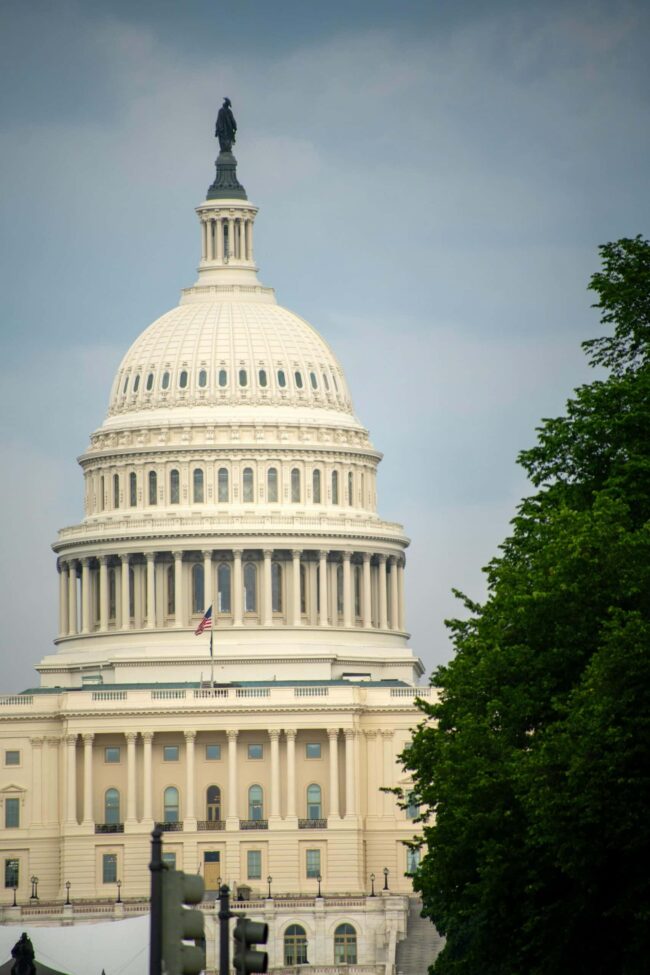
By Marilyn Odendahl
The Indiana Citizen
November 13, 2025
At just 2.29% of CoAction’s $35 million annual budget, the money from the Community Services Block Grant program is truly a drop in the bucket.
However, the roughly $800,000 that comes from the CSBG to the Crown Point-based nonprofit funds innovative responses, such as the homeless diversion program and a savings match initiative, that help catch vulnerable Hoosiers before they fall into poverty. Also, the dollars help plug shortfalls for things like administrative costs in other programs supported by federal dollars, such as the Head Start early-childhood education effort and the Low Income Energy Assistance Program (LiHEAP), which helps pay utility bills.
Jen Trowbridge, president and CEO of CoAction, compared CSBG money to the support that everyone – regardless of where they live or how much money they make – needs at one time or another. An unexpected car repair, an expensive medical bill or even a job loss can push individuals to turn to family and friends for financial help.
“Life is just really difficult, and there’re many, many people that have others to lean on,” Trowbridge said. “We do it all the time. But then there’re these other folks out there who don’t (have anyone else). If they don’t have any option, they will spiral deeper and deeper into debt.”
CSBG funding has been something to lean on for the 22 community action agencies, including CoAction, across Indiana that serve more than 345,000 Hoosiers each year. Since the Community Services Block Grant program was passed by Congress in 1981, billions of dollars have flowed from the federal government to the states and on to the community action agencies for the purpose of alleviating poverty and helping build self-sufficiency. The federal appropriation reached $770 million in fiscal years 2023 and 2024.
The Indiana Housing and Community Development Authority receives CSBG funds from the federal government and then distributes it among the community action agencies across the state. IHCDA did not respond to a question about how much CSBG funding was appropriated to the Hoosier State in the most recent fiscal years.
Agency leaders in Indiana describe the CSBG dollars as flexible. The money, they said, can be used to address problems and fuel efforts that fit the unique needs of their communities. Those funds, if deleted or diminished, could likely not be replaced by other grants or programs, causing the CSBG-supported initiatives to close and possibly reducing the scope of other priorities.
The government shutdown, which choked off federal dollars, not only showed how crucial CSBG funding is for community action agencies, but it also exposed another vulnerability of the program: staffing. While the government was shuttered, the Trump administration fired thousands of federal employees, including those in the Office of Community Services, which is part of the U.S. Department of Health and Human Services and administers the CSBG program.

Even though a deal to reopen the federal government has been reached and the lights are coming back on in federal offices, the worries surrounding the CSBG program have not abated. Capitol Hill’s ingrained practice of passing continuing resolutions to fund the government has kept CSBG recipient organizations constantly unsettled as funding from Washington, D.C., flows and sputters in three- to six-months increments. Also, while the program has always garnered strong bipartisan support and Congress did appropriate money for this fiscal year, the Trump administration eliminated all funding for the CSBG program in its proposed budget submitted earlier this year, indicating it holds a dim view of the renewable block grant.
Ed Gerardot, director of the Indiana Community Action Association, noted the federal government’s fiscal year starts at the beginning of October and that is when the budget should be passed so the agencies know how much money they are going to have for the coming 12 months.
“I don’t think we’ve known that on Oct. 1 for quite a while, because Congress has just ceased to function very well, and so that make it hard for planning purposes,” Gerardot said of the federal budget. “You don’t know what you’re going to get three months from now. You don’t know what you’re going to get six months from now. It makes it crazy.”
Moreover, as leaders of community action agencies in Indiana wait for the federal workers who run the CSBG program to return as the shutdown ends, they are also concerned about their own employees. The constant not knowing what comes next and the additional professional and emotional strain the shutdown imposed has agency heads worried they could lose their most valuable resource.
“I think the fear that I have, that I believe is real, is that the lack of stability will cause the workforce in the Community Action Network to disperse,” Gerardot said. “People are going to say, ‘I’m really tired of this insecurity. I’m going to look for work elsewhere.’ If you start losing your quality experienced staff, you’ve got a problem.”
At the Area Five Agency on Aging and Community Services, a community action agency based in Logansport that serves six counties in north-central Indiana, CSBG money is funneled into the gaps that open in other programs funded by the federal government.
Charles LaDow, executive director of Area Five, said CSBG dollars comprise less than $400,000 of his organization’s $12 million annual budget. Even so, he said, the money creates the infrastructure that underpins the agency’s multiple programs and staff of about 150 employees, giving the nonprofit the flexibility to respond to emergencies and short-term needs.

For example, LaDow said, if a family with a child in Head Start is facing food insecurity, Area Five can dip into the CSBG pot and buy a week’s worth of groceries, so the household can get caught up and return to taking care of itself. Also, earlier this year, the agency used CSBG money to pay for a motel room, until it could find permanent housing for a homeless man who was being released from the hospital after being stabbed while sitting on a bench.
“That block grant is a flexible pot of money that we have the ability to use to make some programs that aren’t whole, whole, and assist people in ways that they might not qualify for some of the (18) different programs we have,” LaDow said. “The design of CSBG is that (it allows) flexible spending to help us reach that mission of fighting the war on poverty and keeping people with nutrition, with health benefits and with housing.”
With many of the 70-plus programs and services provided by Indiana’s community action agencies relying solely or partially on community services block grant funding, any reduction or elimination of those dollars could create what Erin Macey described as a “domino effect.”
Macey, director of the Indiana Community Action Poverty Institute, said the fewer restrictions that CSBG funds have, compared with other federal and private grants, create the potential for other programs to topple if Congress does not appropriate money to the block grant or if the Trump administration does not distribute the dollars. CSBG funding, she said, is the foundation of many other anti-poverty initiatives.
“I think the big question for our agencies, then, is if this funding were to disappear, could we sustain these other programs?” Macey asked. “Like that idea of a domino, if this foundation is pulled out from underneath housing-choice vouchers and individual development accounts and all these other programs, will our agencies need to drop other, bigger programs, because they just don’t sustain themselves on their own?”
In addition to its supporting role, the CSBG funding also fosters some innovative initiatives that help low-income families – many of whom are working but struggling to stay financially afloat.

The homeless diversion program developed and operated by CoAction is one of about eight programs fully supported by CSBG dollars. Trowbridge said the diversion initiative is focused on prevention by helping families who are in danger of becoming homeless stay in their residences and maintain housing stability. And it costs less, since roughly $1,600 can keep a family housed as opposed to several thousands of dollars needed to get a homeless family into permanent housing.
Another of CoAction’s CSBG-supported innovations is a savings match program. Households that save $1,500 over three years will receive a $4,500 match, drawn from other non-CSBG funding sources. Trowbridge said the program “breaks generational poverty” because families can become self- sufficient by using that money for such things as a reliable car, so they can get to work every day, or to take advantage of first-time homebuyer benefits and put a down payment on a house.
“When we invest in people who are trying to make ends meet, trying to work through and navigate, we really are helping our whole economy of our community,” Trowbridge said. “The people thinking (we’re) just helping others who are lazy is not realistic and it’s not reasonable. However they got the stereotype, they just need to check themselves. It’s just wrong facts.”
The Tuesday morning conference calls among the community action agency leaders that Gerardot regularly joins have lately become therapy sessions, he said. Rather than networking and trading ideas, the agency heads talk about the stress they feel not knowing how much CSBG funding will be coming or whether the block grant will be resumed at all.
Gerardot said support from both Republicans and Democrats gives the CSBG program strength and staying power. Still, he noted, CSBG funding could be killed either by Congress not appropriating any money or by the Trump administration shutting off the spigot that lets funds flow to the states.
At Area Five, LaDow scuttled plans to upgrade his organization’s offices because of the interruption caused by the government shutdown. He is using the money that had been saved for building improvements to help keep the agency’s different programs functioning and – since “nobody’s getting rich” working for his agency – to buy food for his employees who depend on SNAP benefits to feed their own families and needed the extra help during the government shutdown.
Also, LaDow estimated he is spending five hours each week on the phone making contingency plans for what may come next. He noted Area Five and the other community action agencies are mission-driven to serve low-income, disadvantaged or disabled individuals and families. CSBG funding, he said, is a key piece of fulfilling that mission.
“I really believe wholeheartedly (that) CSBG is such a good investment in the whole infrastructure of the United States in the war on poverty, because we get a lot of people off of poverty,” LaDow said. “We have a lot of people who (become) independent. That’s our goal. We don’t want them to stay (impoverished). We want to get them to the level playing field and then be OK.”
Dwight Adams, an editor and writer based in Indianapolis, edited this article. He is a former content editor, copy editor and digital producer at The Indianapolis Star and IndyStar.com, and worked as a planner for other newspapers, including the Louisville Courier Journal.
The Indiana Citizen is a nonpartisan, nonprofit platform dedicated to increasing the number of informed and engaged Hoosier citizens. We are operated by the Indiana Citizen Education Foundation, Inc., a 501(c)(3) public charity. For questions about the story, contact Marilyn Odendahl at marilyn.odendahl@indianacitizen.org.